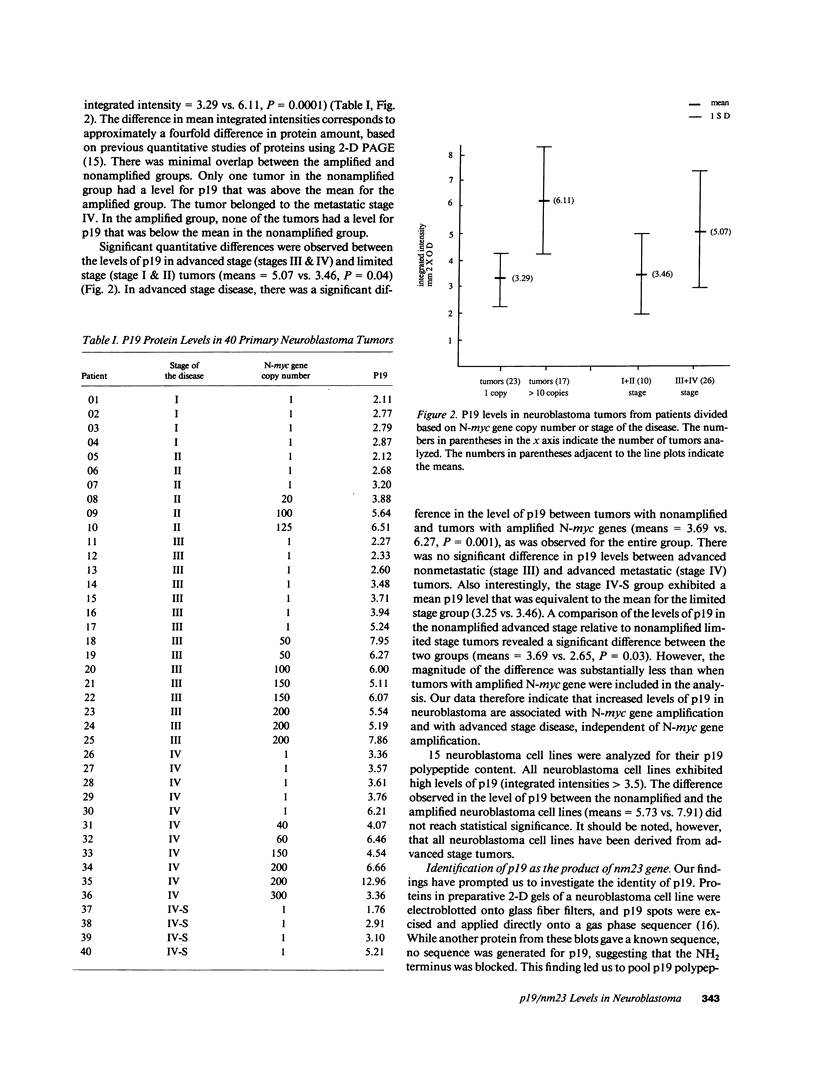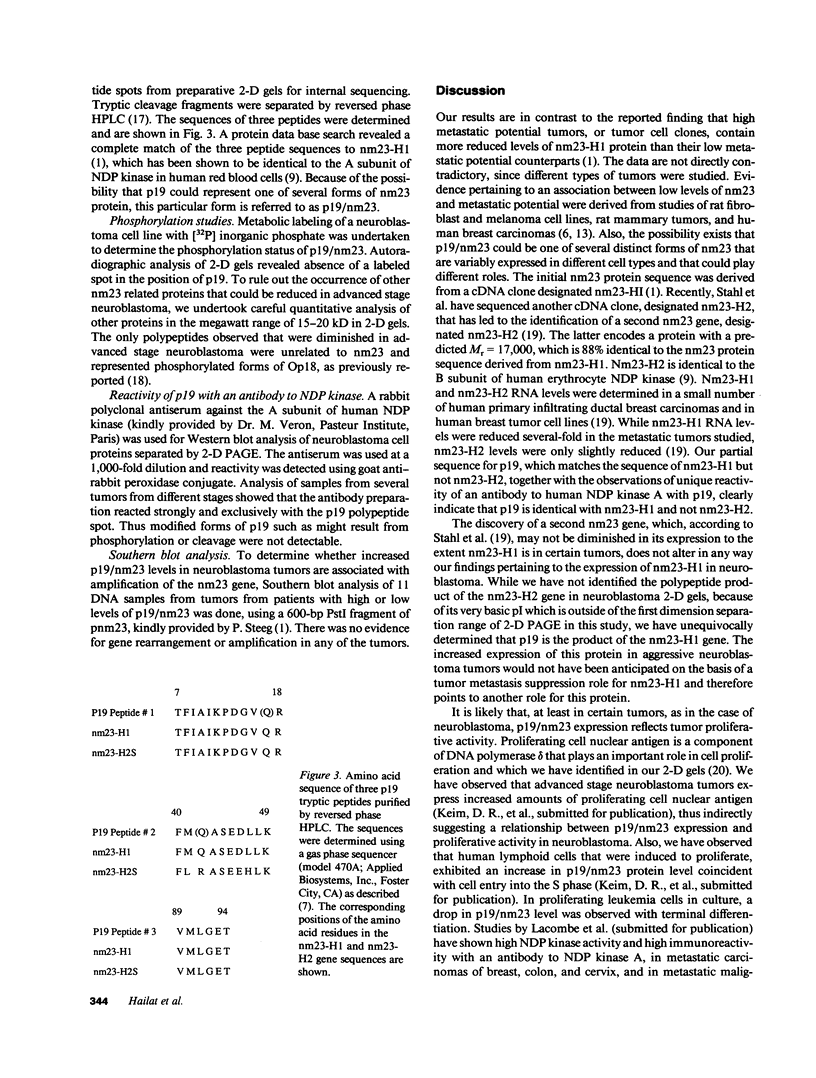Abstract
The gene encoding a novel protein designated nm23-H1, which was recently identified as identical to the A subunit of nucleotide diphosphate kinase from human erythrocytes, has been proposed to play a role in tumor metastasis suppression. We report that untreated neuroblastoma tumors contain a cellular polypeptide (Mr = 19,000) designated p19, identified in two-dimensional electrophoretic gels, which occurs at significantly higher levels (P = 0.0001) in primary tumors containing amplified N-myc gene. The partial amino acid sequence obtained for p19 is identical to the sequence of the human nm23-H1 protein. An antibody to the A subunit of erythrocyte nucleotide diphosphate kinase reacted exclusively with p19. In this study, significantly higher levels of p19/nm23 occurred in primary neuroblastoma tumors from patients with advanced stages (III and IV) relative to tumors from patients with limited stages (I and II) of the disease. Even among patients with a single copy of the N-myc gene, tumors from patients with stages III and IV had statistically significantly higher levels of p19/nm23 than tumors from patients with stages I and II. Our findings indicate that, in contrast to a proposed role for nm23-H1 as a tumor metastasis suppressor, increased p19/nm23 protein in neuroblastoma is correlated with features of the disease that are associated with aggressive tumors. Therefore, nm23-H1 may have distinct if not opposite roles in different tumors.
Full text
PDF




Images in this article
Selected References
These references are in PubMed. This may not be the complete list of references from this article.
- Bevilacqua G., Sobel M. E., Liotta L. A., Steeg P. S. Association of low nm23 RNA levels in human primary infiltrating ductal breast carcinomas with lymph node involvement and other histopathological indicators of high metastatic potential. Cancer Res. 1989 Sep 15;49(18):5185–5190. [PubMed] [Google Scholar]
- Biggs J., Tripoulas N., Hersperger E., Dearolf C., Shearn A. Analysis of the lethal interaction between the prune and Killer of prune mutations of Drosophila. Genes Dev. 1988 Oct;2(10):1333–1343. doi: 10.1101/gad.2.10.1333. [DOI] [PubMed] [Google Scholar]
- Dearolf C. R., Hersperger E., Shearn A. Developmental consequences of awdb3, a cell-autonomous lethal mutation of Drosophila induced by hybrid dysgenesis. Dev Biol. 1988 Sep;129(1):159–168. doi: 10.1016/0012-1606(88)90170-4. [DOI] [PubMed] [Google Scholar]
- Dearolf C. R., Tripoulas N., Biggs J., Shearn A. Molecular consequences of awdb3, a cell-autonomous lethal mutation of Drosophila induced by hybrid dysgenesis. Dev Biol. 1988 Sep;129(1):169–178. doi: 10.1016/0012-1606(88)90171-6. [DOI] [PubMed] [Google Scholar]
- Eckerskorn C., Mewes W., Goretzki H., Lottspeich F. A new siliconized-glass fiber as support for protein-chemical analysis of electroblotted proteins. Eur J Biochem. 1988 Oct 1;176(3):509–519. doi: 10.1111/j.1432-1033.1988.tb14308.x. [DOI] [PubMed] [Google Scholar]
- Hailat N., Strahler J., Melhem R., Zhu X. X., Brodeur G., Seeger R. C., Reynolds C. P., Hanash S. N-myc gene amplification in neuroblastoma is associated with altered phosphorylation of a proliferation related polypeptide (Op18). Oncogene. 1990 Nov;5(11):1615–1618. [PubMed] [Google Scholar]
- Hanash S. M., Gagnon M., Seeger R. C., Baier L. Analysis of neuroblastoma cell proteins using two-dimensional electrophoresis. Prog Clin Biol Res. 1985;175:261–268. [PubMed] [Google Scholar]
- Keim D., Hailat N., Hodge D., Hanash S. M. Proliferating cell nuclear antigen expression in childhood acute leukemia. Blood. 1990 Sep 1;76(5):985–990. [PubMed] [Google Scholar]
- Merril C. R., Goldman D., Sedman S. A., Ebert M. H. Ultrasensitive stain for proteins in polyacrylamide gels shows regional variation in cerebrospinal fluid proteins. Science. 1981 Mar 27;211(4489):1437–1438. doi: 10.1126/science.6162199. [DOI] [PubMed] [Google Scholar]
- Nisen P. D., Waber P. G., Rich M. A., Pierce S., Garvin J. R., Jr, Gilbert F., Lanzkowsky P. N-myc oncogene RNA expression in neuroblastoma. J Natl Cancer Inst. 1988 Dec 21;80(20):1633–1637. doi: 10.1093/jnci/80.20.1633. [DOI] [PubMed] [Google Scholar]
- Otero A. D. Transphosphorylation and G protein activation. Biochem Pharmacol. 1990 May 1;39(9):1399–1404. doi: 10.1016/0006-2952(90)90420-p. [DOI] [PubMed] [Google Scholar]
- Rosengard A. M., Krutzsch H. C., Shearn A., Biggs J. R., Barker E., Margulies I. M., King C. R., Liotta L. A., Steeg P. S. Reduced Nm23/Awd protein in tumour metastasis and aberrant Drosophila development. Nature. 1989 Nov 9;342(6246):177–180. doi: 10.1038/342177a0. [DOI] [PubMed] [Google Scholar]
- Stahl J. A., Leone A., Rosengard A. M., Porter L., King C. R., Steeg P. S. Identification of a second human nm23 gene, nm23-H2. Cancer Res. 1991 Jan 1;51(1):445–449. [PubMed] [Google Scholar]
- Steeg P. S., Bevilacqua G., Kopper L., Thorgeirsson U. P., Talmadge J. E., Liotta L. A., Sobel M. E. Evidence for a novel gene associated with low tumor metastatic potential. J Natl Cancer Inst. 1988 Apr 6;80(3):200–204. doi: 10.1093/jnci/80.3.200. [DOI] [PubMed] [Google Scholar]
- Steeg P. S. Search for metastasis suppressor genes. Invasion Metastasis. 1989;9(6):351–359. [PubMed] [Google Scholar]




